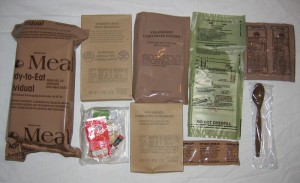Army Hopes to Deploy 3D Food Printers
Latest News
August 29, 2014
During a family vacation one year when I was around nine years old, an Army National Guard unit spent the night at the same hotel where my parents and I were encamped for the week. I was fascinated with the trucks and the weapons and the guardsmen themselves, and they very graciously gave me a mini-tour of their convoy. Later, before they left, they handed me a couple of parting gifts: two boxes of actual military rations.
I thought they were pretty cool souvenirs, and after we returned from vacation I decided to try one out for lunch. It was disgusting. Barbequed meat in a can? Blackberry jam the consistency of caulking? Yuck.
Meals, Ready-to-Eat (MREs) have come a long way since then, and by all accounts they are significantly more edible than in the past. Now, in a very “Star Trek”-like development, the U.S. Army is investigating how 3D printing could help generate custom food for deployed troops.
The 3D food printers could potentially be used to allow soldiers to generate rations on site, which would be much less costly than packaging and shipping food and eliminate waste, according to researchers at the Natick Soldier Research, Development, and Engineering Center (NSRDEC) in Massachusetts.
Using chemical substrates to print the food would allow the creation of food that could meet both the culinary tastes and nutritional needs of individual soldiers. The process is called ultrasonic agglomeration, and it uses high-frequency sound waves to cause clumps of particles to clump together. Modulating the sound controls how the food constituents bind.
That could make it easier for food researchers to create compact, stable and good tasting food.
“It could reduce costs because it could eventually be used to print food on demand,” said Matt Scerra, NSRDEC food technologist. “For example, you would like a sandwich, where I would like ravioli. You would print what you want and eliminate wasted food.”
“Printing of food is definitely a burgeoning science,” said Lauren Oleksyk, and military food technologist. “It’s currently being done with limited application. People are 3D printing food. In the confectionery industry, they are printing candies and chocolates. Some companies are actually considering 3D printing meat or meat alternatives based on plant products that contain the protein found in meat.”
In the field, having the ability to create food on demand opens up even more possibilities.
“We are thinking as troops move forward, we could provide a process or a compact printer that would allow soldiers to print food on demand using ingredients that are provided to them, or even that they could forage for,” Oleksyk said. “This is looking far into the future.”
Source: The Fiscal Times
Subscribe to our FREE magazine, FREE email newsletters or both!
Latest News
About the Author
Brian Albright is the editorial director of Digital Engineering. Contact him at [email protected].
Follow DERelated Topics







